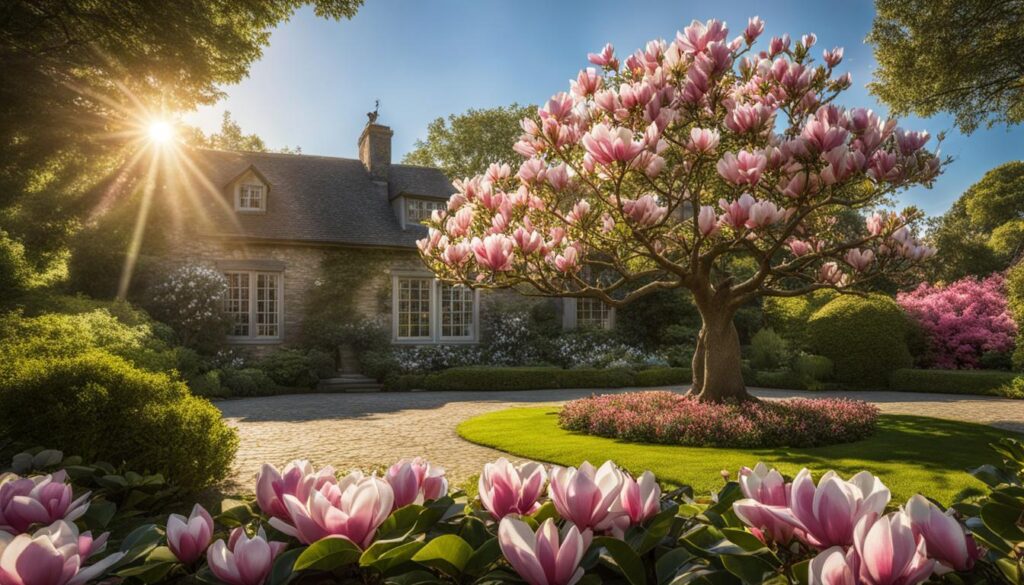
How To Grow Magnolias In The UK
Magnolias are a beautiful addition to any garden, and despite their delicate appearance, they can thrive in the UK climate. Whether you’re a gardening enthusiast or a beginner, growing magnolias can be a rewarding experience. In this article, we will explore the essential aspects of magnolia tree care, from planting to pruning, and provide tips on choosing the best magnolia species for the UK climate.
Before diving into the details, it’s important to understand the key factors that contribute to successful magnolia cultivation. By following the right practices, you can enjoy the beauty of magnolias in your own backyard. Let’s get started!
Key Takeaways:
- Choose magnolia tree varieties that are suitable for the UK climate.
- Plant magnolias in slightly acidic or neutral soil in a sheltered spot with sun or light shade.
- Water new magnolia plantings regularly and keep them well-watered during dry spells.
- Feed magnolias annually for the first few years to help them establish.
- Prune magnolias lightly in mid-summer to early autumn, taking care not to over-prune.
Choosing the Right Magnolia for Your Garden
When selecting a magnolia, it’s important to consider your preferences for flower color and flowering time. Most magnolias have white or pink flowers, with some cultivars displaying maroon, dark purple, yellow, or cream blossoms. The size and shape of the flowers can also vary. Additionally, magnolias differ in their ultimate size, from small shrubs to large trees. Choose a magnolia that suits the space you have available in your garden. It’s also essential to consider the soil type, as magnolias generally prefer slightly acidic or neutral soil, although some varieties can tolerate alkaline or chalky soils.
Here’s a list of popular magnolia varieties with their flower colors, flowering times, ultimate sizes, and preferred soil types:
| Magnolia Variety | Flower Color | Flowering Time | Ultimate Size | Soil Type |
|---|---|---|---|---|
| Magnolia stellata | White | Early spring | Small shrub – up to 3m (10ft) | Slightly acidic to neutral soil |
| Magnolia soulangeana | Pink and white | Early to mid-spring | Small tree – up to 6m (20ft) | Slightly acidic to neutral soil |
| Magnolia grandiflora | White | Summer to autumn | Large tree – up to 18m (60ft) | Neutral to slightly alkaline soil |
| Magnolia liliiflora | Purple | Spring and sporadic flowering throughout the year | Medium-sized shrub – up to 2.5m (8ft) | Slightly acidic to neutral soil |
Remember to choose a magnolia that suits your garden’s space, matches your desired flower color and flowering time, and thrives in your soil type. This way, you can enjoy the beauty of magnolias in your garden throughout the year.

Planting and Caring for Magnolias in the UK
Magnolias thrive in the UK when planted in full sun and fertile, moist, well-drained soil. To ensure the health and beauty of your magnolias, it’s essential to follow proper care and maintenance practices. Let’s explore some key aspects of magnolia care:
Magnolia Planting
When planting magnolias, choose a well-drained location that receives full sun. Prepare the soil by adding organic matter, like compost, to improve its fertility and drainage. Dig a hole that is wide and deep enough to accommodate the root ball. Gently place the magnolia in the hole, ensuring that the top of the root ball is level with or slightly above the soil surface. Backfill the hole with soil, firming it gently around the roots. Finally, water the newly planted magnolia thoroughly.
Magnolia Watering
Proper watering is crucial for the establishment and growth of magnolias. In the first few years after planting, regularly water the magnolia, especially during dry spells. Aim to keep the soil consistently moist but not waterlogged. Mulching the root zone with organic matter can help retain moisture and regulate soil temperature.
Magnolia Feeding
Feeding magnolias annually for the first few years will help them establish and promote healthy growth. Apply a balanced, slow-release fertilizer in early spring to provide essential nutrients. Follow the manufacturer’s instructions for application rates.
Magnolia Mulching
Mulching the root zone of magnolias with organic matter, such as leaf compost or wood chips, is beneficial. Apply a layer of mulch around the base of the plant, ensuring it doesn’t touch the trunk. Mulching helps retain moisture, suppresses weeds, and improves soil structure.
Magnolia Pruning
Pruning magnolias should be done lightly in mid-summer to early autumn. Remove any dead, damaged, or crossing branches to maintain a healthy and well-shaped tree. It’s important not to over-prune magnolias, as excessive pruning can affect their blooming. If you have older magnolias that require renovation pruning, seek advice from a professional arborist.
| Aspect of Magnolia Care | Key Tips |
|---|---|
| Magnolia Planting | Choose a well-drained, sunny location. Prepare the soil with organic matter. |
| Magnolia Watering | Regularly water newly planted magnolias and keep them well-watered during dry spells. |
| Magnolia Feeding | Feed magnolias annually using a slow-release, balanced fertilizer in early spring. |
| Magnolia Mulching | Mulch the root zone with organic matter to retain moisture and suppress weeds. |
| Magnolia Pruning | Prune lightly in mid-summer to early autumn, removing dead or crossing branches. |
By following these planting and caring tips, you can ensure the success and vitality of your magnolias in the UK. Remember to provide adequate water, nutrients, and appropriate pruning, and your magnolias will reward you with their stunning blooms for years to come.
Propagating Magnolias in the UK
If you’re looking to expand your collection of magnolias or share their beauty with others, propagating magnolias can be an exciting and rewarding process. There are several methods you can use to propagate magnolias, including layering and cuttings.
Layering
Layering is a technique that involves bending a low branch of a magnolia tree towards the ground and burying a section of it in the soil. Over time, the buried section will develop roots, creating a new plant that can be separated from the parent tree and potted up. Layering is a reliable method for propagating magnolias, especially for those with branches close to the ground.
Cuttings
Another popular method for propagating magnolias is through cuttings. Softwood cuttings are taken from the new growth tips in spring, while semi-ripe cuttings are collected from the current season’s growth in summer. To improve the chances of success, it’s recommended to dip the cuttings in a rooting hormone before inserting them into well-draining soil. With proper care and attention, these cuttings will develop roots and can be transplanted to their permanent location.
When propagating magnolias through either layering or cuttings, it’s important to remember that different magnolia varieties may require different techniques. Research the specific propagation requirements for your chosen magnolia variety to ensure the best results.
Propagation in Containers
Magnolias can also be successfully propagated in containers, making them an excellent choice for those with limited garden space or for creating portable displays. When propagating magnolias in containers, it’s crucial to use a suitable potting mix that provides adequate drainage. Additionally, regular watering and feeding will be essential for the healthy growth of your container-grown magnolias.
To summarize, propagating magnolias in the UK can be accomplished through layering and cuttings. Each method offers its own advantages, and choosing the right technique will depend on the specific magnolia variety and your preferences. Whether you’re a gardening enthusiast looking to expand your collection or someone with limited garden space, magnolia propagation opens up exciting possibilities for cultivating and sharing the beauty of these magnificent trees.

Conclusion
Growing magnolias in the UK can add a touch of beauty and elegance to your garden. With the right magnolia variety, planting conditions, and care, you can create a stunning display of these magnificent trees or shrubs. Whether you prefer the charm of small magnolias or the grandeur of large ones, and whether you adore the purity of white blossoms or the vibrancy of colored flowers, there is a magnolia species that will thrive in your garden.
To ensure the success of your magnolia garden, it is essential to choose the right location for planting. Providing adequate water and nutrients is also crucial for their health and growth. Additionally, following proper pruning techniques will help maintain the beauty of your magnolias over time.
By implementing these magnolia gardening tips, you will be able to cultivate a flourishing magnolia paradise in your UK garden. Enjoy the beauty and fragrance of these enchanting trees as they grace your outdoor space with their exquisite blooms year after year.
FAQ
How do I choose the right magnolia for my garden?
When selecting a magnolia, consider your preferences for flower color and flowering time, as well as the ultimate size of the plant and the soil type.
What are the different flower colors and flowering times of magnolias?
Most magnolias have white or pink flowers, but there are also cultivars with maroon, dark purple, yellow, or cream blossoms. Flowering times can vary between early and late in the season.
How do I plant and care for magnolias in the UK?
Magnolias thrive when planted in full sun and fertile, moist, well-drained soil. Regular watering and feeding during dry spells, as well as mulching with organic matter, can help them establish. Light pruning should be done in mid-summer to early autumn.
How can I propagate magnolias in the UK?
Magnolias can be propagated through layering and cuttings. Layering involves burying a low branch until it develops roots, while cuttings can be taken from softwood or semi-ripe wood and treated with rooting hormone. Magnolias can also be grown in containers.
What are some tips for growing magnolias in the UK?
Choose a magnolia species that is suitable for the UK climate, plant it in the right location with proper soil and sunlight conditions, provide regular watering and feeding, and follow appropriate pruning techniques to ensure the health and beauty of your magnolias.